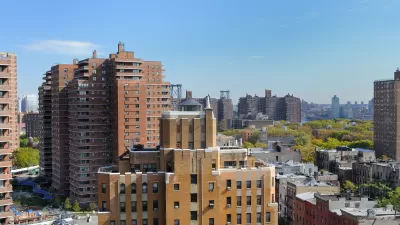A controversial affordable housing project proposed for Somerville, Mass. diffused community opposition by coordinating with the for-profit developer of an adjacent parcel. Could the partnership provide a template for moderating NIMBYism?
"Proposals for affordable housing developments elicit predictable opposition, summed up in the familiar acronym, NIMBY—Not In My Back Yard—is the well-known shorthand for complaints about offensive land uses, offending architectural designs, and traffic disruption," writes Laurie Goldman. "While these concerns are sometimes justified, the discourse frequently veils one of the most pronounced reasons residents oppose affordable housing: fears that the presence of low-income households (and people of color) will increase crime rates, drive down property values, and fundamentally change the neighborhood’s character."
But by coordinating their plans to build 40 units of workforce rental housing with the for-profit developer of the former funeral home next door to their site, The Somerville Community Corporation (SCC) may have found a replicable recipe for navigating NIMBY hurdles.
"Taken together, the two projects form a defacto mixed-income development without reducing the number of affordable units SCC is able to provide," says Goldman. "The two developers plan to adopt common design elements so that there are minimal differences between the affordable and market-rate developments. The fact that each contracts with the same property management company also promises to foster harmonious relations among residents of both complexes."
"The prospects of the coordinated development appear to be having an effect on the NIMBY discourse," she adds. "The comments that followed the joint presentation of the proposal at last week’s Planning Board meeting were decidedly less abrasive."
FULL STORY: A New Way to Diffuse NIMBYism?

Study: Maui’s Plan to Convert Vacation Rentals to Long-Term Housing Could Cause Nearly $1 Billion Economic Loss
The plan would reduce visitor accommodation by 25,% resulting in 1,900 jobs lost.

North Texas Transit Leaders Tout Benefits of TOD for Growing Region
At a summit focused on transit-oriented development, policymakers discussed how North Texas’ expanded light rail system can serve as a tool for economic growth.

Why Should We Subsidize Public Transportation?
Many public transit agencies face financial stress due to rising costs, declining fare revenue, and declining subsidies. Transit advocates must provide a strong business case for increasing public transit funding.

How to Make US Trains Faster
Changes to boarding platforms and a switch to electric trains could improve U.S. passenger rail service without the added cost of high-speed rail.

Columbia’s Revitalized ‘Loop’ Is a Hub for Local Entrepreneurs
A focus on small businesses is helping a commercial corridor in Columbia, Missouri thrive.

Invasive Insect Threatens Minnesota’s Ash Forests
The Emerald Ash Borer is a rapidly spreading invasive pest threatening Minnesota’s ash trees, and homeowners are encouraged to plant diverse replacement species, avoid moving ash firewood, and monitor for signs of infestation.
Urban Design for Planners 1: Software Tools
This six-course series explores essential urban design concepts using open source software and equips planners with the tools they need to participate fully in the urban design process.
Planning for Universal Design
Learn the tools for implementing Universal Design in planning regulations.
City of Santa Clarita
Ascent Environmental
Institute for Housing and Urban Development Studies (IHS)
City of Grandview
Harvard GSD Executive Education
Toledo-Lucas County Plan Commissions
Salt Lake City
NYU Wagner Graduate School of Public Service





























